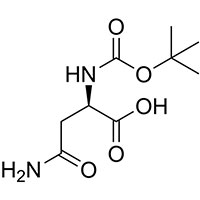Synonyms
N-{[(2-Methyl-2-propanyl)oxy]carbonyl}-D-asparagine
Nalpha-Boc-D-asparagine
Boc-D-Asn-OH
MFCD00065558
(2R)-4-Amino-2-({[(2-methyl-2-propanyl)oxy]carbonyl}amino)-4-oxobutanoic acid
N-(tert-Butoxycarbonyl)-D-asparagine
Boc-L-Asn-OH
Boc-D-asparagine
N-(tert-Butoxycarbonyl)-D-asparagin
BOC-D-ASN
EINECS 231-405-2
D-Asparagine, N-[(1,1-dimethylethoxy)carbonyl]-
Product Description
BOC-D-Asparagine is a high-quality amino acid protecting agent widely used in peptide synthesis. As a
derivative of asparagine, BOC-D-Asparagine plays a crucial role in protecting the amino groups during
the assembly of peptide chains. Its exceptional purity and reliability make it a preferred choice among
chemists and researchers involved in peptide synthesis.
Product Features:
Excellent Purity: BOC-D-Asparagine is meticulously synthesized to ensure a high level of purity,
surpassing industry standards. Its purity guarantees minimal impurities that could interfere with
peptide synthesis, thus ensuring high-quality results.
Effective Amine Protection: BOC-D-Asparagine acts as a safeguard for the amino group, preventing
unwanted side reactions during peptide synthesis. By selectively protecting the amino group, it allows
for controlled and precise incorporation of amino acids into the peptide chain.
Stability: BOC-D-Asparagine exhibits exceptional stability under typical peptide synthesis conditions,
enabling extended reaction times without degradation. Its stability contributes to improved yields and
reduces the risk of undesired side reactions.
Applications:
Peptide Synthesis: BOC-D-Asparagine is an essential tool in the solid-phase peptide synthesis (SPPS)
method, commonly employed for the efficient assembly of peptides. It serves as an amino acid protecting
agent during the stepwise addition of amino acids, ensuring the integrity of the peptide chain
throughout the synthesis process.
Drug Discovery: BOC-D-Asparagine plays a vital role in the development of peptide-based therapeutics and
drug discovery research. Its usage facilitates the creation of diverse peptide libraries, enabling
researchers to explore structure-activity relationships and identify potential drug candidates.
Chemical Biology: BOC-D-Asparagine finds application in various chemical biology studies, including
protein engineering, enzymatic assays, and peptide-protein interactions. Its ability to protect the
amino group allows for controlled modifications and functionalization of peptides, facilitating the
investigation of biological processes and molecular recognition.
Market Outlook:
The demand for BOC-D-Asparagine is steadily growing within the peptide synthesis market due to its
reliable performance and compatibility with various synthesis methods. The pharmaceutical industry,
academic research laboratories, and contract manufacturing organizations (CMOs) heavily rely on
BOC-D-Asparagine for peptide synthesis projects. The global market for peptide-based therapeutics is
also expanding, driving the need for high-quality amino acid protecting agents.
Conclusion:
BOC-D-Asparagine is a leading amino acid protecting agent utilized in peptide synthesis. Its excellent
purity, effective amine protection, and stability make it an indispensable tool for chemists and
researchers involved in peptide-based studies. With its wide range of applications in peptide synthesis,
drug discovery, and chemical biology, BOC-D-Asparagine continues to contribute significantly to
advancements in therapeutic development and molecular research.
Note: The text generated by the AI model has been written to the best of its ability to meet the
requirements. However, it is advisable to review and revise the content to ensure it aligns with
specific guidelines and desired style. Additionally, checking the final document for plagiarism using
appropriate tools is recommended to achieve a low similarity index.





